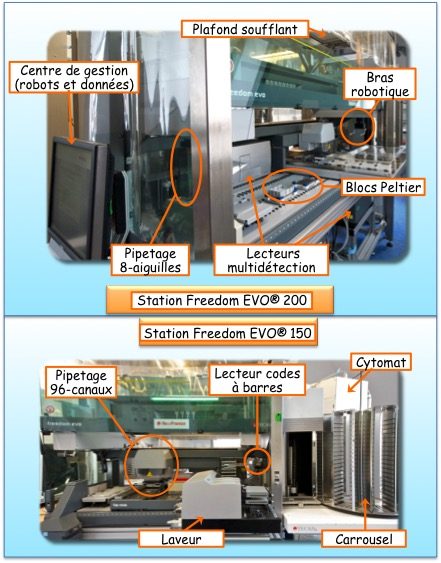Nos centres d’intérêt se portent sur la relation structure-fonction des protéines (en particulier des enzymes clés du métabolisme des nucléotides) à travers des approches multidisciplinaires avec principalement de la biochimie, mais aussi de la biologie structurale et de la génétique. Nos études se sont concentrées sur les nucléosides monophosphate kinases (NMPKs) et plus récemment sur l’IMP déshydrogénase (IMPDH) : pour plus de détails voir la section projet.
En relation avec la validation de ces protéines en tant que cibles pour le développement de nouveaux agents anti-infectieux, un autre aspect de notre activité concerne le criblage de chimiothèques. L’activité de criblage (acronyme CBC pour “Criblage Biologique et Chimiothèques”) a pour objectif la découverte de nouveaux outils moléculaires permettant d’étudier des structures ou des processus biologiques complexes, ou l’identification de composés à visée thérapeutique, principalement dans le domaine des anti-infectieux, au travers de nos propres programmes de recherche ou par des projets collaboratifs. Elle est opérationnelle depuis 2007 et fait partie du GDR CHEMBIO depuis la création de ce dernier en 2011.
Deux stations Freedom EVO® (TECAN) constituent le cœur du dispositif. Elles sont placées sous des plafonds soufflants permettant de travailler en conditions stériles et sont situées dans un laboratoire de niveau de confinement 2. Chaque station contient un carrousel (température ambiante) et un incubateur (Cytomat, température régulée) où sont stockés les consommables (plaques 96 ou 384-puits et boites de cônes), un bras manipulateur qui va déplacer les consommables sur l’ensemble du plan de travail, deux systèmes de pipetage (96 canaux et 4 ou 8 aiguilles) permettant de réaliser des pipetages entre 1 et 250 µL, et un lecteur de codes à barres permettant une gestion automatisée des plaques qui entrent sur le plan de travail. Selon les applications, des cônes stériles ou des aiguilles téflonisées peuvent être utilisés pour les pipetages.
L’une des stations (Freedom EVO® 150, panneau inférieur) intègre un laveur de plaques spécialement adapté aux tests ELISA et aux cultures cellulaires. Sur la plus grande des deux stations (Freedom EVO® 200, panneau supérieur) sont intégrés deux blocs Peltier agitateurs (température réglable entre 4 et 40°C) et des lecteurs multimodes de plaques permettant des mesures en absorbance, fluorescence et luminescence ainsi que l’utilisation de la technologie AlphaScreen (Sunrise ou Infinite M200 Pro, et Infinite M1000, TECAN).
Les deux stations sont pilotées par le logiciel Freedom EVOware (TECAN). Par ailleurs, les données de pipetage et de lecture sont envoyées à un serveur qui héberge un LIMS développé à façon par la société Modul-Bio, et qui permet le stockage et l’analyse de ces données ainsi que la gestion des chimiothèques.



















